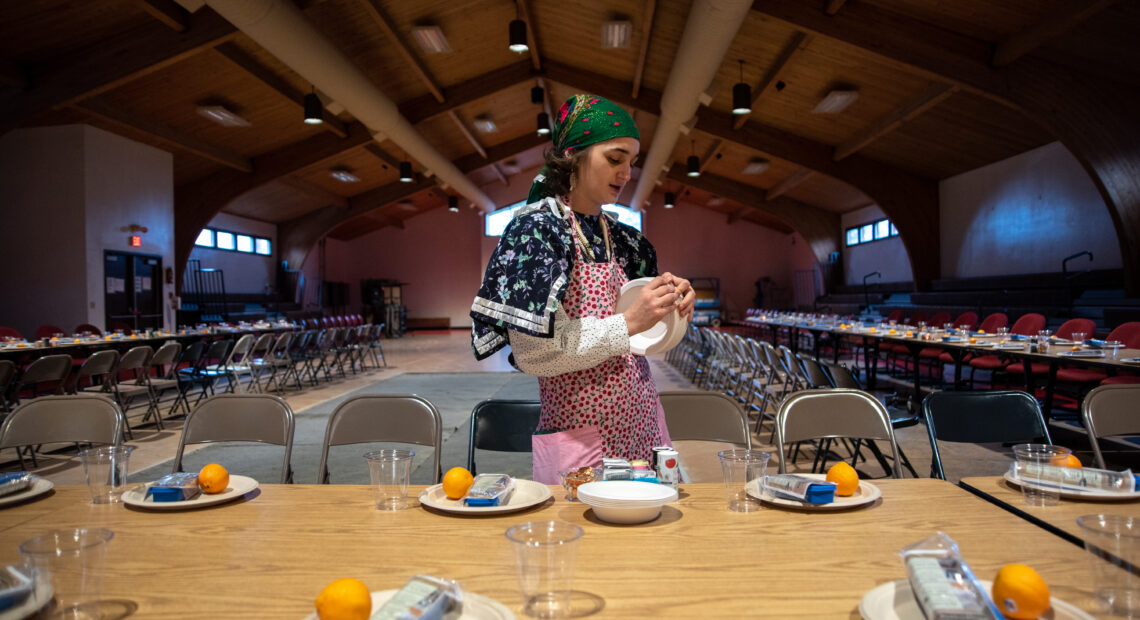
Winter solstice is also ‘Indian New Year’ in the Northwest
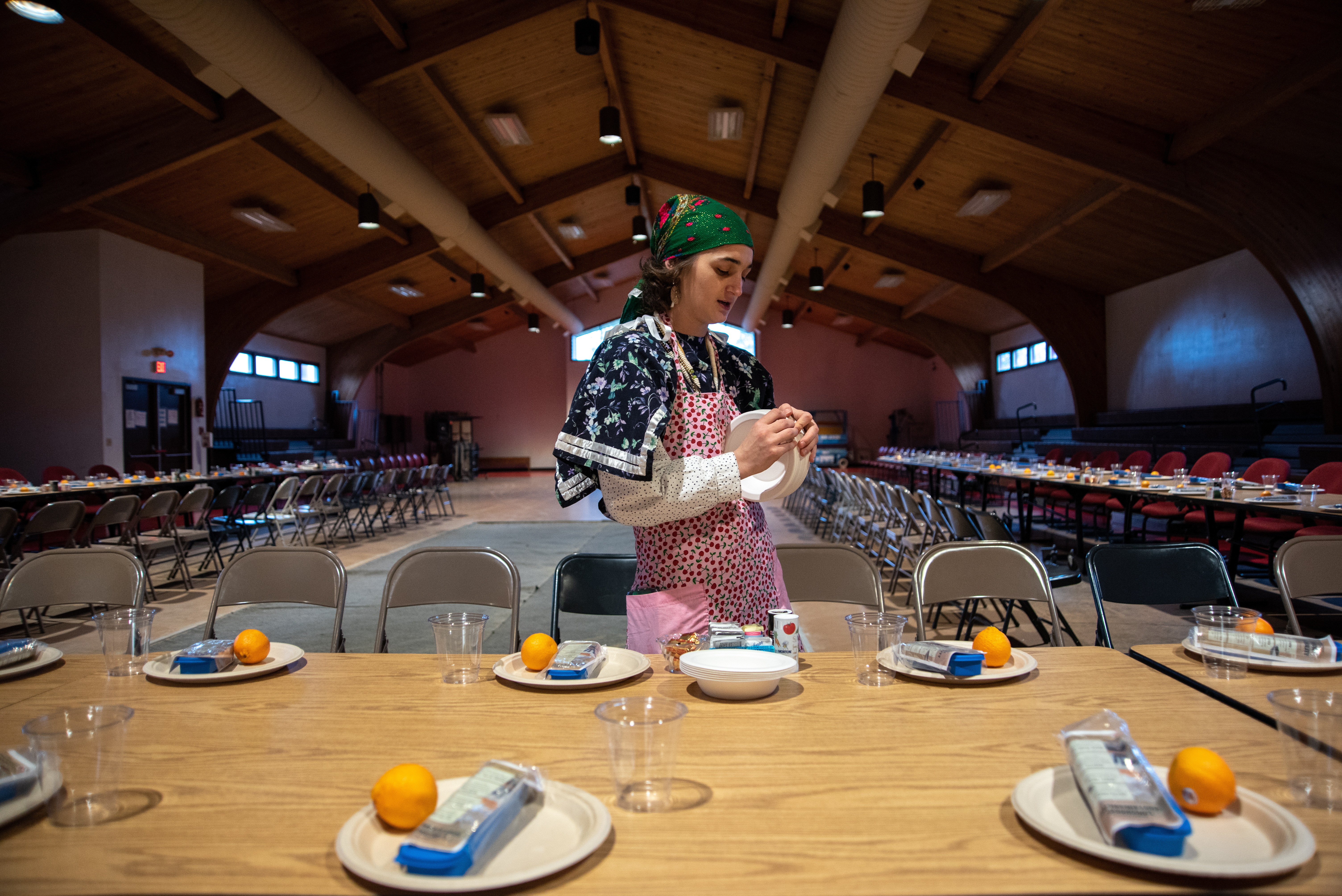
Listen
(Runtime 1:00)
Read
Wing dresses embellished with tiny shells jingle a bit as huge hugs are thrown between friends and relatives.
This is the day “the sun turns around” – winter solstice, Dec. 21. But it’s also the so-called “Indian New Year” for many tribes across Washington, Oregon and Idaho.
At the longhouse in Mission, Oregon, on the Confederated Tribes of the Umatilla Indian Reservation, around 200 people gather to ring in goodwill and high hopes for a plentiful and happy new year, as they honor the tribes’ reciprocal relationship with sacred first foods.
Braiding her sons’ hair before the festivities begin is Kola Shippentower, 34.
“My two boys that do have long hair, I am usually the only one that braids their hair,” she said. “Being their mom, our boys’ hair is really special and so, with every braid, I usually say a prayer for them every morning as they go out in their day – whether to school or whatever the case may be. But for tonight – it’s preparing for the Indian New Year.”
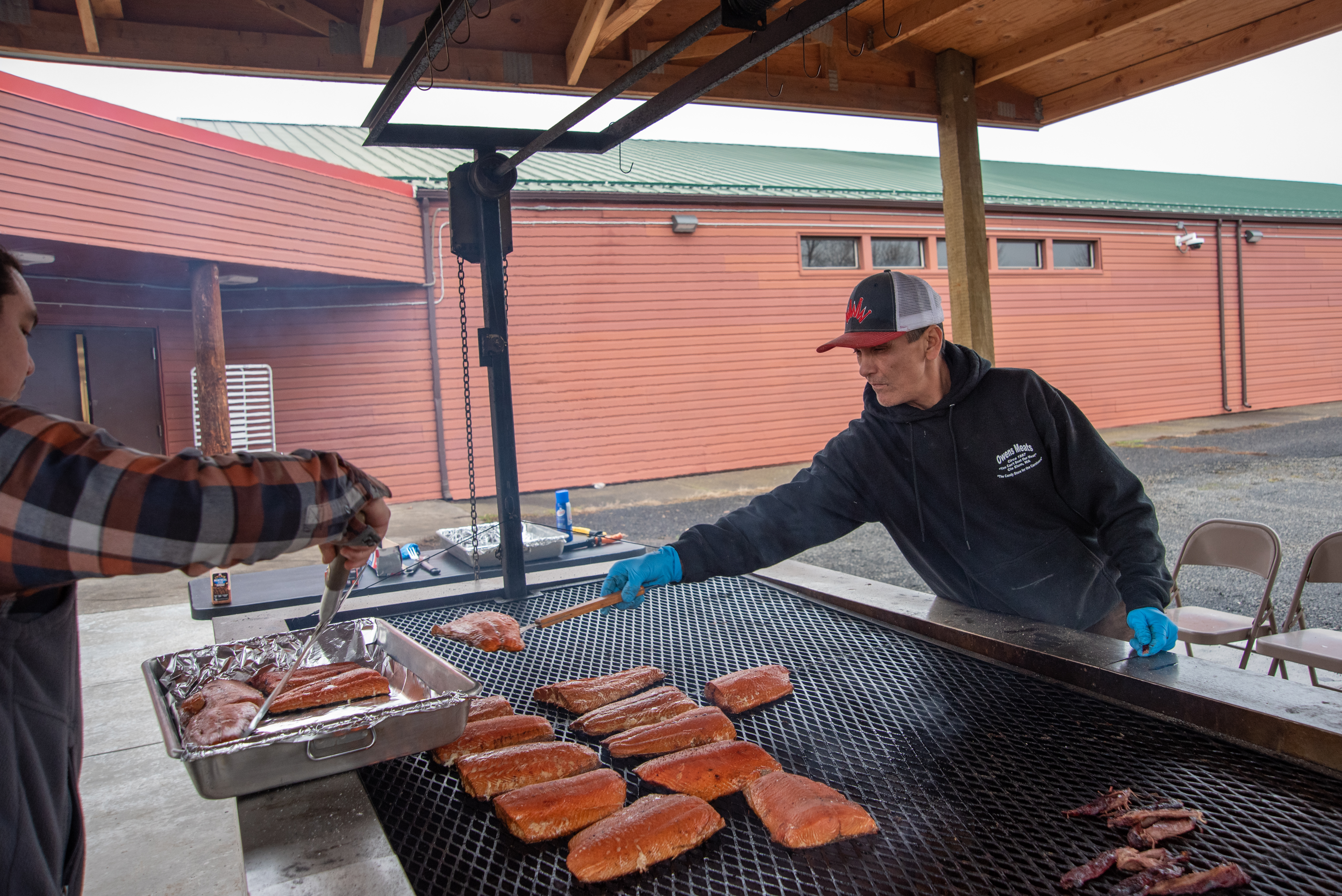
Longhouse cooks Freddy WarBonnet, right, and Andrew Wildbill grill up salmon, an important first food, for the Confederated Tribes of the Umatilla Indian Reservation Indian New Year feast on Dec. 21 in Mission, Ore. (Credit: Annie Warren / NWPB)
Dinner for 200
Outside on a massive grill, Spring Chinook filets roast and spit over the fire. In the kitchen, a dozen women and girls prep foods of all kinds for the coming guests.
There is núsux or salmon – x̣áwš or roots – tmɨ́š or chokecherries – wíwnu or huckleberries and ɨwínat or wild meat. Then there are all the non-traditional foods to prepare: A giant belly of frybread, noodles and deer, ham, turkey, potatoes, potato salad, jello salad, pies, cakes and cupcakes frosted and sprinkled.
This celebration is joyous but also bittersweet. Many elders who once brought joy and their hands’ work to this longhouse are no longer here.
“I really miss my grandma. Everything about the longhouse was her favorite,” said Trinette Minthorn, one of the lead women in the kitchen, directing the work. “And I understand that now and it makes me miss her. But, I’m glad I’m still doing what she taught us, and I’m passing that on to my daughter.”
Everyone gathers for the meal first. There is some singing and drumming – although journalists are not allowed to take pictures or record the songs because it’s a sacred ceremony.
Then comes the tasting of water, or čúuš, served in individual clear cups. Next, a taste of the traditional foods as they’re called out one by one by the tribes’ spiritual leader, Armand Minthorn. They’re called by their native names, “núsux! ɨwínat! pyax̣í!” and as each name is called, everyone forks up a tiny bite of salmon, meat or wild roots off their plate.
“The Indian New Year for us, the shortest [daylight] day of the year, it marks a change with our Mother Nature,” Armand Minthorn said. “Like the old people would say, the sun, it turns around and it begins to shine a new light and it’s for our Indian food. Our Indian foods will start coming back. We pray for that food and that it will be plentiful to nourish our body and our heart and help us work on our life with that new food.”
He said the people continue using ceremony and song to recognize this change in the seasons.
“Our old people, generations before us, did the same thing,” he said. “We’re still carrying it, what we heard from them and what they showed us.”
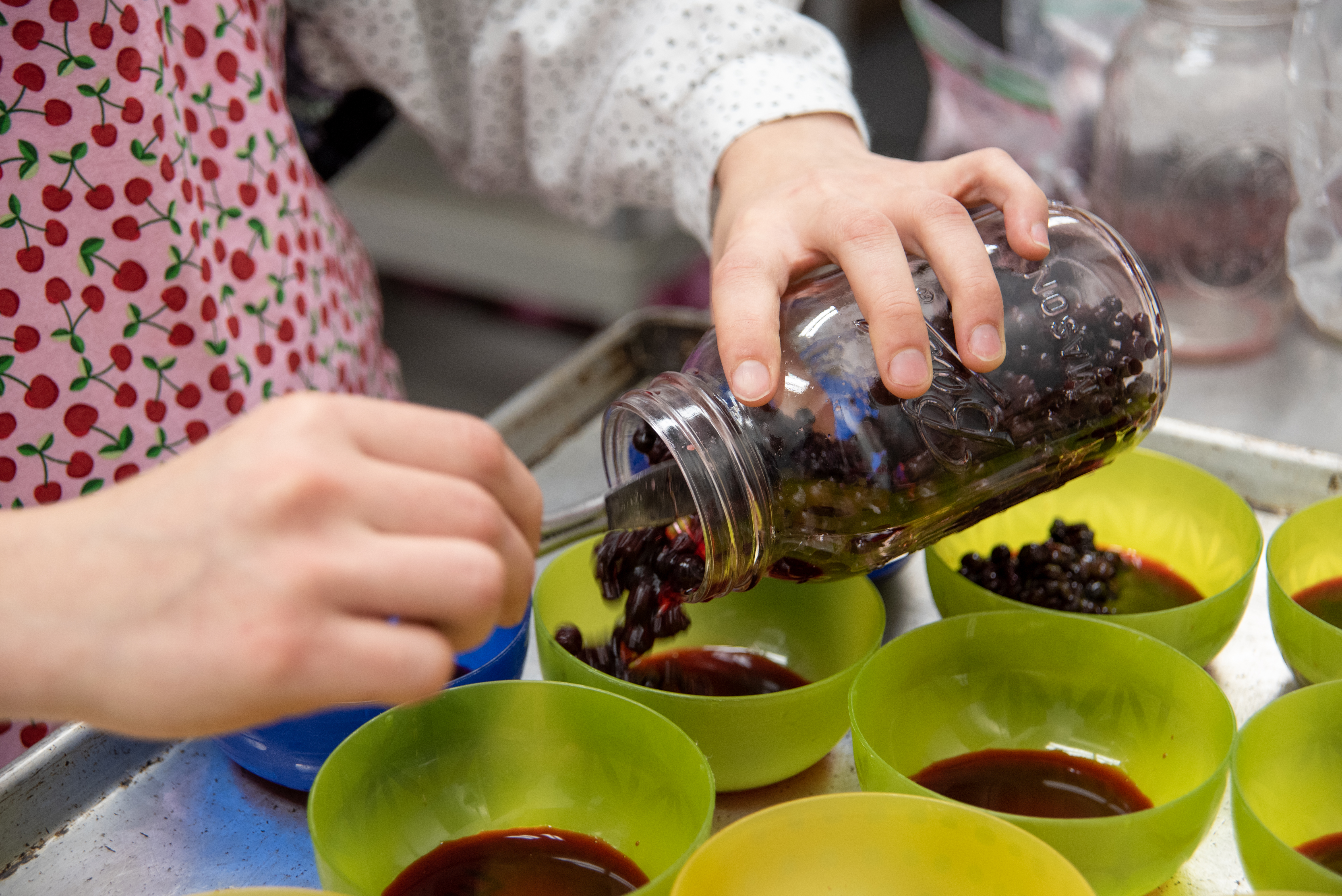
Cloe McMichael prepares trays of huckleberries, a sacred first food for Northwest tribes, for the Confederated Tribes of the Umatilla Indian Reservation annual Indian New Year feast on Dec. 21 in Mission, Ore. (Credit: Annie Warren / NWPB)
Not a funeral
Some dinner guests, across the table, said they were happy to be in the longhouse for a joyful event – something hopeful. In big families, there always seems to be a funeral to go to.
People pass red Kool-Aid and deer meat across the table. They laugh, look at their cell phones and snatch at the coveted frybread. Oily-springy-salty-delicious, the bread quickly empties out of the brightly-colored baskets. Young children and their mothers alike smear the bread with packets of butter and chomp into them.
Speeches with a microphone near the elder’s table are made.
It was also an elder’s birthday – the entire longhouse filled with the tune of “Happy Birthday.” Then, an Indigenous Mexican woman from Portland, Oregon speaks into the mic; she brought lilies to honor the event.
Cloe McMichael, 22, said she misses these events when she is at college in Corvallis, Oregon from September through June.
“I try to use my language as much as I can in today’s world,” she said. “To keep that connection to the past and the people that came before me. It’s important to keep the language as it keeps us connected to all of our other traditions.”
McMichael said she gets pretty sad being away from her tribal home, here at the longhouse.
“I see the positives of being in school,” she said. “But it’s hard being away.”
The dance
A dance circle started slowly – moving counter-clockwise.
People faced forward, then moved to the right in half steps, bouncing.
The tribes in Lapwai, Idaho and Warm Springs, Oregon and the Yakama tribes in Washington, were all celebrating at the same time this night, too.
They’re dancing to prepare themselves for the new foods that will come in the wheel of seasons over this next year.
They’re dancing for hope. They’re dancing to remember those mothers, fathers, aunties and uncles who have passed on. Dancing is a prayer.
Armand Minthorn said he’s worried about climate change for the traditional foods’ longevity.
“We usually have snow by now,” he said. “We only had one snowfall several weeks ago. We have to keep praying and we have to keep recognizing our Indian food and we have to go with whatever our Creator plans.”
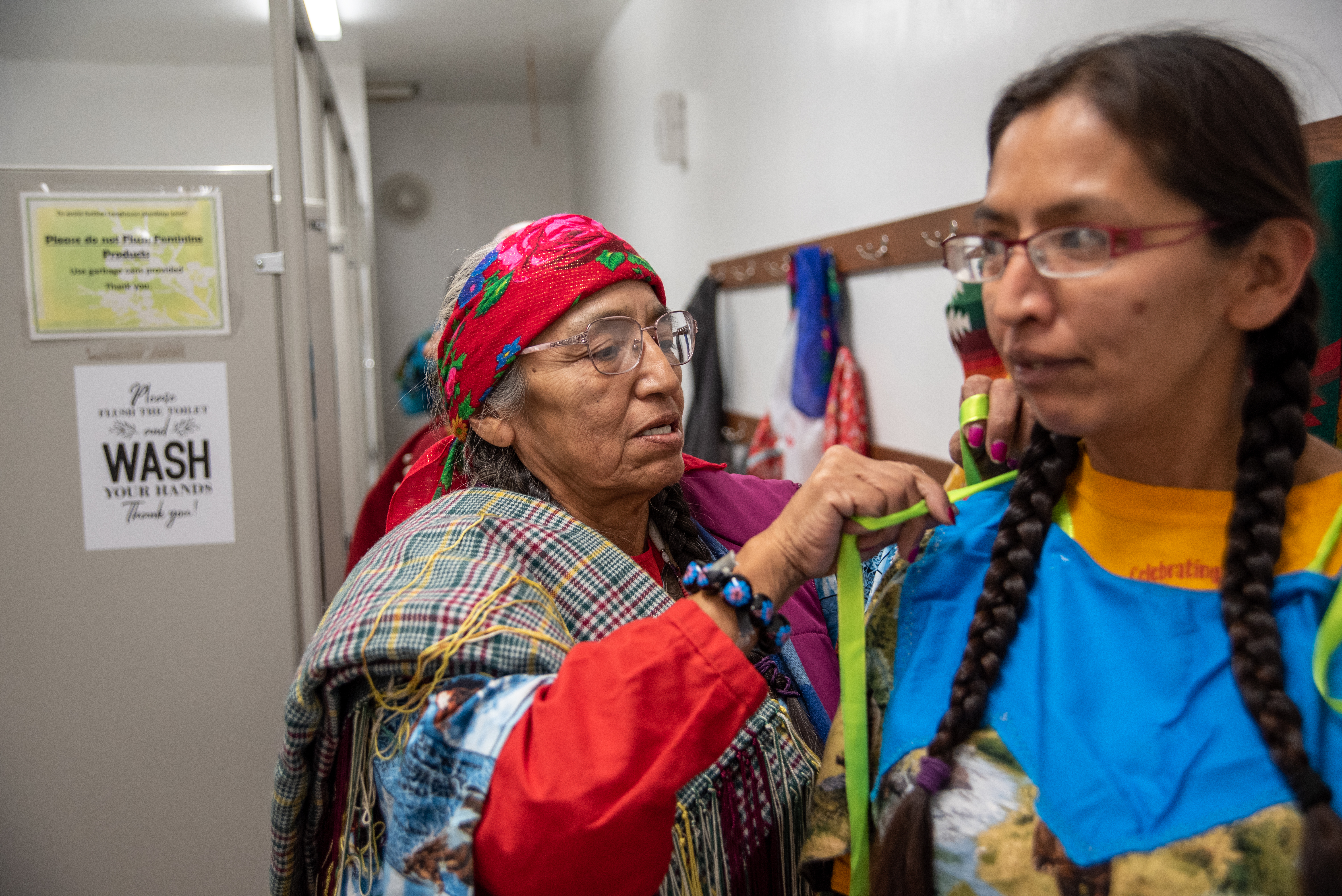
Cindy Yallup, left, ties the ribbons of daughter Norma Patrick’s wing dress as the women prepare for Indian New Year at the longhouse in Mission, Ore., on Dec. 21. They were visiting from the Yakama reservation and said they enjoyed seeing family and hearing the singing and the laughter in the kitchen. (Credit: Annie Warren / NWPB)
Everyone on the wash
After hours of dancing, nearly everyone comes out to the wash.
The wash is the open, packed clay that’s at the center of the longhouse.
It’s significant because it represents the earth and the land. “When we have service, that ground, it lights up,” Armand Mintorn said.
Dancing strengthens the body and the heart of the people, Armand Minthorn said.
Beaded moccasins hop in unison. The women and men in a line, oldest to youngest — going around in a long undulating serpentine of humans.
“We go around like that, it makes us closer as family and as people,” said Armand Minthorn. “We’re all supporting each other. We all need each other.”
Nearly 200 people, all singing, drumming and dancing together.
Turning counterclockwise, to bring in the new year.
“It’s the same way the earth turns,” said Armand Minthorn. “And we turn as well. As we go around, we recognize this land – it’s always moving and we go in the same direction.”















